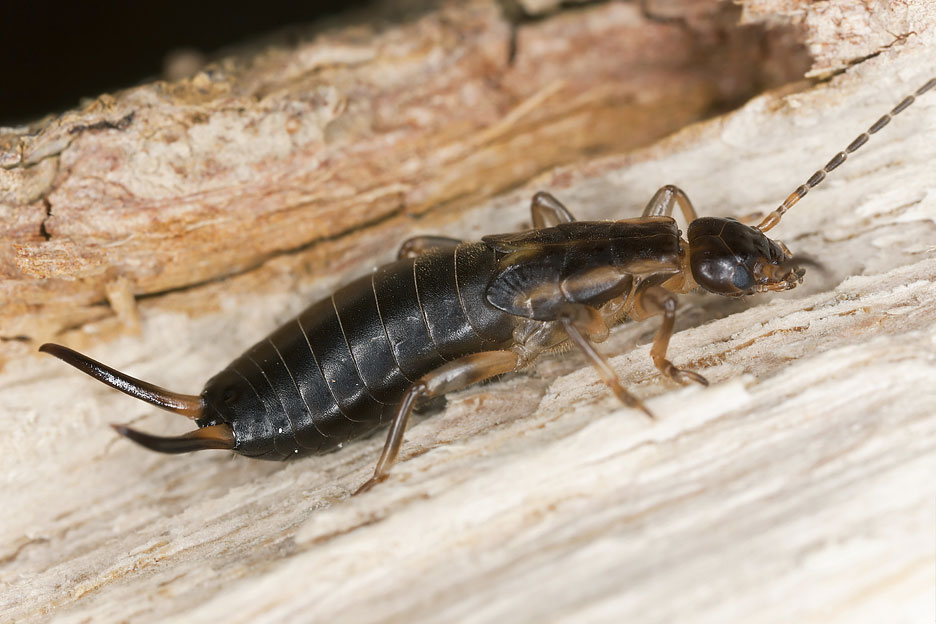Earwigs
Earwigs are among the most easily recognized insects in the home and landscape. They are abundant throughout Texas and can be a nuisance when they invade houses. Although earwigs rarely harm people, the insects’ large, pincer-like appendages, called forceps, can appear formidable. Some earwig species emit a foul-smelling, yellowish brown liquid from their scent glands, but the most common complaint against the earwig is its presence in homes and apartments.
Because of their flattened bodies, earwigs can enter homes through tiny cracks. However, they are accidental invaders and generally do not reproduce indoors. A few earwig species feed on crops and ornamental plants, but most play a beneficial role by feeding on other insects.
The earwig’s name comes from a European superstition that the insect would enter the ear of a sleeping person and bore into the brain.
About 20 species of earwigs live in the United States. Of those, about 10 occur in Texas, although only four cause occasional problems in homes: the ringlegged earwig, Euborellia annulipes (Lucas); the riparian earwig, Labidura riparia (Pallas); the linear earwig, Doru lineare (Eschscholtz); and the brown-winged earwig, Vostox brunneipennis (Serville).
Biology and habits. Earwigs range from 1/4 to 1 1/4 inches (5 to 31 mm) long and are flattened from top to bottom. Their color ranges from brown to black; some species have yellow or buff-colored stripes or a reddish coloring on the head, body, and legs.
All earwigs have a pair of hardened forceps that protrude backward from the tip of the abdomen. Used for defense, the appendages vary among species and from male to female.
The adult earwig has a short, leathery pair of wings. A second pair of membranous wings may be folded underneath the first pair.
Earwigs have chewing mouthparts, which they use to catch and eat insects. Earwigs feed at night, and their diet is highly variable. Most earwig species prey on other insects—dead and living—and supplement their diet with decaying organic matter. They may also feed on algae, fungi, lichens, and mosses. Indoors, they may feed on houseplants or sweet, oily, or greasy foods.
Earwigs are temporary pests in landscapes and gardens, even in large populations. They may feed on the foliage of landscape and garden plants and other nearby plants. Large populations can seriously damage flowers, fruits, vegetables, and other plants, making the leaves appear ragged with many small, irregular holes.
Earwigs develop through gradual metamorphosis from egg to nymph to adult. The immature form, or nymph, looks much like the adult but is grayish and lacks fully developed wings and large forceps.
Females lay from 20 to 300 eggs, usually in a chamber in the soil. The female guards the eggs and newly hatched young. After the first molt, or shedding of the exoskeleton, the immature earwigs leave the nest to fend for themselves. Two generations are produced each year.
Earwigs prefer moist conditions and migrate indoors during prolonged heat and drought to seek cool, moist hiding places. In winter they can dig as deep as 6 feet into the ground to escape freezing temperatures.
Management. To manage earwigs, use combinations of strategies such as sanitation, exclusion, mechanical methods, and, as a last resort, chemical treatments.
Reduce hiding places for earwigs around the outside of house by removing ornamental stone or excessive mulch (more than 2 inches deep) near the foundation. Keep the grass mowed and weeds cut short.
Eliminate damp conditions in crawl spaces under homes and around outside faucets, near air conditioning units and in other places. Rain gutters and spouts should carry water away from the house’s foundation. Indoors, fix leaky plumbing and eliminate other high-humidity areas.
If only an occasional earwig comes indoors, remove it with a broom, dustpan, or vacuum cleaner. If earwigs come indoors often, inspect the area to determine how they are entering the structure, and seal cracks and entry points. Use sealant and weather stripping around doors, windows, pipes, and other places to exclude the insects. In structures with brick or stone façades, use steel wool or copper mesh to seal weep holes. Do not use steel wool on light-colored facades because it will rust if it gets wet.
Outside, check low areas closely because earwigs generally enter the home at the ground level. Trapping can reduce populations outside. Make traps from rolled-up newspaper, corrugated cardboard, bamboo tubes, or short pieces of hoses, and place them on the soil near plants or other sites that may hide earwigs. Check the traps the next morning and shake out any accumulated earwigs into a pail of soapy water. Continue trapping until no more earwigs are caught.
Please don’t hesitate to call us for additional eco-friendly solutions.
